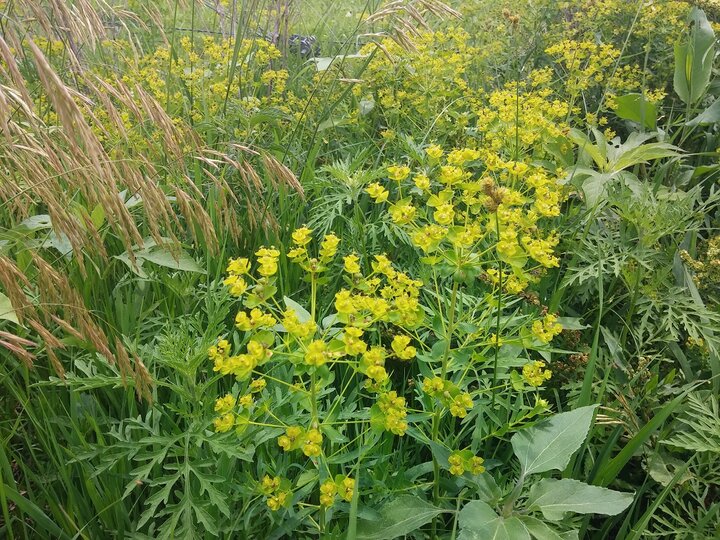The bright yellow-green of leafy spurge can put a damper on the joy of spring green-up. The noxious weed is especially noticeable in early June. That’s also one of the best times to invest the time and money into controlling leafy spurge.
Unfortunately, a single treatment will not control leafy spurge once established, so continued monitoring and retreatment is needed. An effective strategy is pairing spring applications that prevent seed production with a fall treatment to control new growth.
While herbicides and control methods are vital to reducing leafy spurge populations, mapping or marking infestations is one of most important steps in the process, and it’s cheap, quick and easy.
Whether spraying in the fall or spring, marking leafy spurge patches physically with colored tape, by map, or with GPS is essential for full control. This makes repeat spraying of patches easier and ensures dormant seed that’s late germinating, or a stray plant hasn’t been missed. With its prolific reproductive capabilities, even one mature leafy spurge plant can quickly form a new patch.
About Leafy Spurge
Leafy spurge is an introduced perennial on the state noxious weed list. It spreads aggressively and is hard to control once established. Standing 1-3 feet tall, spurge plants have simple deep-green, lancelet leaves. Plants flower in late May to early June with bright yellow-green bracts surrounding the true flower. One definite identifier of leafy spurge is the milky sap the entire plant produces when stems or leaves are damaged. This sap is irritating to cattle, preventing them from grazing spurge patches.
Leafy Spurge Control Options
Control of spurge is difficult due to its prolific root system and aggressive reproductive tendencies. Leafy spurge spreads by both seed and buds on rhizomes and roots. A single plant can produce an average of 140 seeds, spreading them up to 20 feet away when mature. The roots and underground rhizome system can extend 15 feet or more. This prolific root system allows spurge to bounce back after control measures, and when damaged, can produce new plants from numerous root buds. This makes one-time tilling more likely to spread leafy spurge than provide control.
Biological controls like spurge-feeding insects or grazing by goats or sheep can be utilized successfully to limit aboveground growth, but will not control plants completely. Both options can be time-intensive and take some research and planning to implement effectively. Cultural control methods like fire and mowing can have the same effect, primarily damaging aboveground growth. Both methods, properly timed, can increase later herbicide effectiveness by limiting seed production and stressing plants.
Matching the herbicide to the growth stage is the key to effective herbicide selection for controlling leafy spurge.
Spring (Bud Stage) Leafy Spurge Herbicide Control Options
- 2,4-D ester
- Graslan L®
- Tordon 22K®
- Picloram 22K
Spring (Flowering Stage) Leafy Spurge Herbicide Control Options
- Curtail®/Cody®/Stinger®
- Streamline®
- Mix of Overdrive® + Tordon 22K®
- Mix of Sharpen® + Plateau® (Note that the Plateau® label prohibits this herbicide from being applied in the spring over areas treated the previous fall.)
Leafy spurge is not an easy opponent to take on. It can easily take over a pasture, reducing grazing capacity. However, with regular treatment and monitoring, it can be contained and controlled.
Interviews with the authors of BeefWatch newsletter articles become available throughout the month of publication and are accessible at https://go.unl.edu/podcast. You can subscribe to the BeefWatch newsletter here: http://go.unl.edu/Beefwatch_subscribe.
Topics covered:
Grazing systems & best practices, Pasture & range, Weed & pest management, Pasture & range

